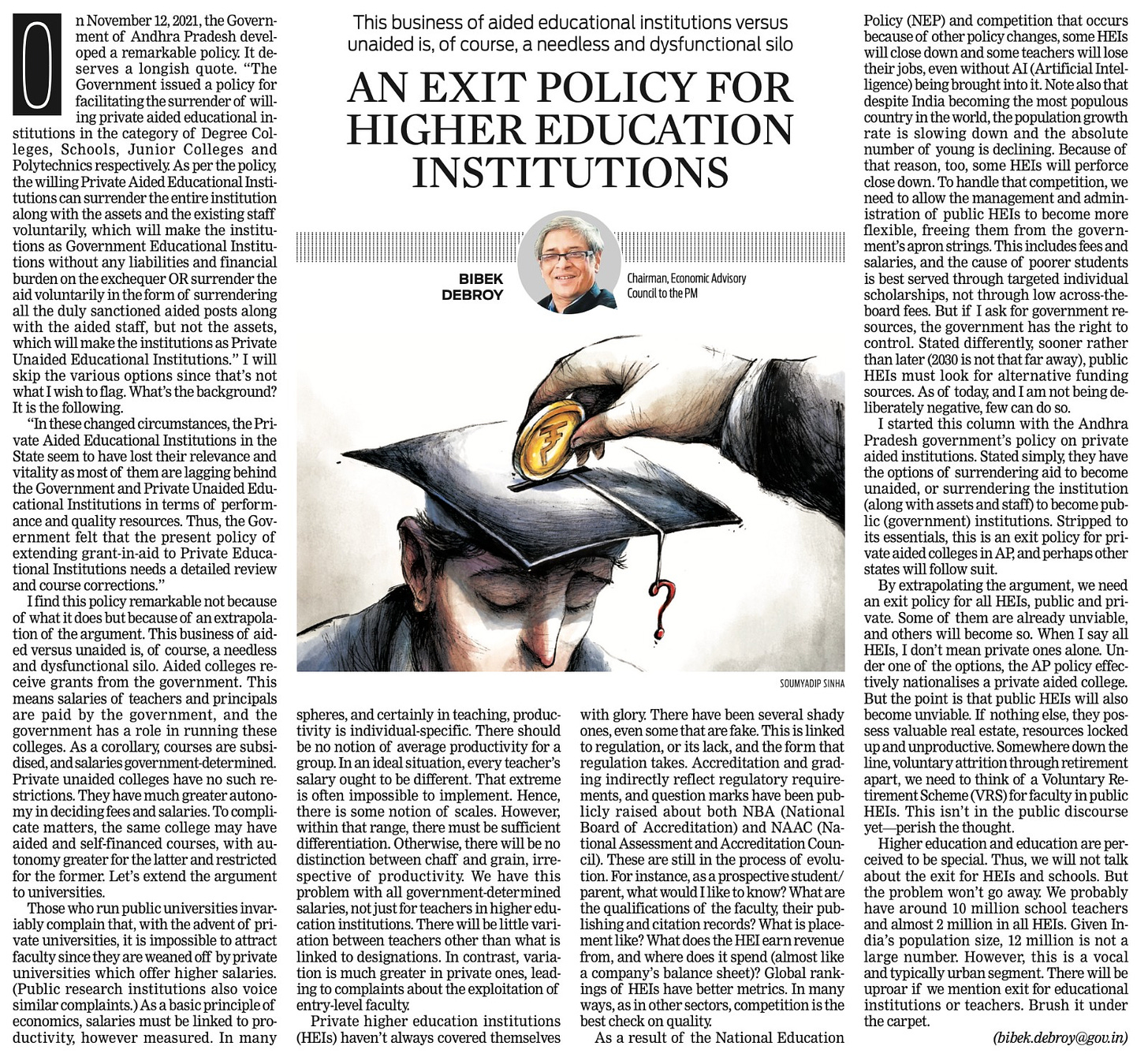"For-profit" Institutions of Higher Education: An alternative to the Exit Policy
Formally allowing “for-profit” companies in the higher education and school education sector may solve many problems that bedevil this important sector. The downside risk is small.
Today, Mr Bibek Debroy, Chairman of the Economic Advisory Council to the Prime Minister, wrote an article captioned “An Exit Policy for Higher Education Institutions” (https://www.newindianexpress.com/opinions/2023/may/06/an-exit-policy-for-higher-education-institutions-2572411.html) In the same, he analyses a recent policy initiative dated12.11.2021 of the Government of Andhra Pradesh, which provides an enabling framework for the private state-aided colleges to surrender, on a purely voluntary basis, the staff and posts, but sans other physical assets or liabilities to the State Government, as one of the various options. Arguing the case further, within the context of the National Education Policy (NEP), he describes this as an “exit” route. He concludes with an opinion that the HEIs must be permitted more alternatives of such “exits”, while expressing a view that the School Education sector continues to be too politically charged a domain to even risk an informed debate on the same.
TMA Pai Foundation Judgement: As an IAS officer of Punjab cadre, I had the occasion to work as the Administrative Secretary of various government departments dealing with the broad field of education: School Education; High Education; Technical Education and Medical Education. In these postings, as also as the Principal Secretary Finance, one dealt with the subject of “state-aided schools and colleges”. Incidentally, I had just been posted as Secretary Technical Education, when the landmark judgement by a 5-Judge Constitutional Bench of the Supreme Court of India in the case of TMA Foundation vs. the State of Karnataka was pronounced in the year 2002.
This was a paradigm-shifting verdict. In essence, it laid down that while the private unaided educational institutions were free to run their day-to-day affairs and administration, including recruitment of teachers and admission of students, without the interference of the Government, yet the State Governments could, by law, stipulate the standard of education and also regulate the fee structure. It permitted “profits” but not “profiteering”.
It contained one observation, which has stuck with me: “Education is per se regarded as an activity that is charitable in nature.” (paragraph 20 of the judgement). As I delved deeper in the subject, as my career progressed, I found that while profit-making institutions—school as well as colleges-- were not explicitly barred by the regulatory framework, these were not actively encouraged. As a matter of fact, “a charitable institution” was the default setting for any school or college to be affiliated with the Central Board of School Education (CBSE) or the State School Education Boards or the State University having the territorial or functional jurisdiction.
Only “not-for-profit” entities allowed? The private educational institutions were required to be “non-proprietary” in character and were generally required to be either a Society registered under the Societies Registration Act, 1860 or a Charitable Trust under the Indian Trusts Act, 1882. In a few cases, not-for-profit companies under the Companies Act of 2013 (previously Companies Act, 1956) were also permitted. The broad essence was that “for profit” companies—whether private limited or public limited—were frowned upon, if not entirely disqualified from affiliation. As a matter of fact, I am yet to see any such affiliated or recognized educational institution in Punjab or the neighbouring states with the legal structure of a “for-profit” company, registered under the extant Companies Law.
Like companies running in a competitive environment, private educational institutions can also fail. This is more so now, since the barrier to new entry is low and new players/ institutions can come in, as long as these meet the standards of the affiliating Board/ University. Such educational institutions may also require capital to expand and resources of the founders/ promoters/ members of the Board of Governors may not always be sufficient. Debt may not always be available from the banks or other financial institutions. The legal structure of a Society or a Trust makes it very difficult, if not entirely impossible, for these institutions to be sold as a “running concern”, or merged with other such institutions, or simply liquidated or closed down. And, we are not even talking about our labour laws and other questions whether teachers and the administrative staff would be construed as “workmen” within the meaning of the labour laws and the institutions themselves regarded as “industrial establishments”.
Gray market for sale-purchase of educational institutions: We do hear about schools and colleges being sold—either at a loss or with huge profits—in the market. These are all-cash deals wherein the new members of the Governing Board or the trustees of the trust are inducted, while the previous ones resign sequentially. We also hear about inter se settlement between the members/ trustees in case of buy-outs and/ or settlement of disputes. These are also all-cash deals. Some disputes between the Board members/ Trustees are so belligerent, that these end up ruining the very institution they profess to administer.
My policy prescription— allow “for-profit” companies: My policy prescription is simple. Let us openly and unabashedly encourage privately owned/ managed schools and colleges, that are structured as “for profit” private or public limited companies. Of course, these would continue to be bound by the appropriate laws as regards the regulation of fees chargeable from the students and also in adhering to the infrastructure and educational standards of the affiliating Board or University. These could be merged or demerged under the appropriate laws or raise capital by way of equity shares etc. The regulation by the Registrar of Companies and SEBI, in case of listed companies, would concurrently be there. They would also be eligible for debt-restructuring under the Insolvency and Bankruptcy Code (IBC), 2016.
Conclusion: In summary, an exit need not always be the closure or liquidation of an institution, which has huge issues regarding the jobs of the teachers and other staff and also the future of the students. Taking over by the Government, as in case of AP under its new policy may be one option, but we as a country need look beyond that. In a scenario, where “minimum government, maximum governance” is the order of the day, this is a simple policy instrument that we should be willing to experiment with. Since, education is a subject in the “concurrent list” some progressive states may be willing to take the plunge, even before the Government of India is a bale to forge a national consensus. The downside is limited but the upside is huge.
__________________________________________________________________
Author: KBS Sidhu, retired in 2021 after 37 years of service as a Punjab cadre IAS officer.
Graphics have been generated by the author using “Dream Studio” #AI software.
kbs.sidhu@gmail.com








Here in the US the big difference between private and state universities is funding. Historically , private universities have lot more resources available because of philanthropy. But management, performance and competitiveness plays huge role in attracting donors.
Private institutions should not be discouraged but theme , role, spirit and meaning of education should not get lost. There must be transparency ( setting up board of regents made of educators , administrators). Preferably absence of religious tones. An independent accrediting agency for high schools ( here: National association of independent schools website NAIS , advancED website Covina, and similar agencies are for colleges ( NECHE, ACCHC etc) . All private and state educational institutions should be inspected , ranked and needed improvement recommendation are to be implemented within time given by the agency. system like that will promote excellence , accountability, public trust and keep it profitable.